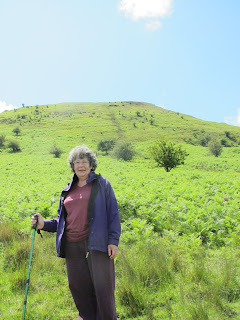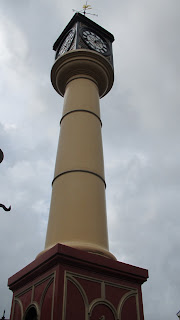Tramroads, the precursor to the modern day railway, at one time, criss-crossed the Welsh valleys like snail trails. Long wooden rails resting on wooden sleepers have been recorded as far back as 1695.
The beechwood was quickly worn away by iron wheels, so around 1738 iron plates were used to repair them. Gradually iron rails replaced the beechwood completely. Styles of track varied with the local Engineer, but the cost of iron rails with stone sleepers surrounded by stones and gravel, in the 18th century was around £1,000 per mile.
Many iron forges were constructed along the river banks, allowing easy transport by barge to the sea. Unfortunately, this was not possible for every forge, as rivers were not conveniently situated on steep hillsides. Also, coal and limestone needed to be transported to the forge, as well as the iron to their customers.
Tramroads were the result of manufacturers struggling to transport heavy iron, limestone and coal to market. Mules hauled trucks along rutted unmade roads, eroded by wear, and littered with loose rubble. Roads that were often flooded by heavy rain, and many unpassable in winter, by subsidence on the steep hillsides. Rails made life much easier for the poor mules to haul a series of up to four trams. They would not become bogged down, and the connection of wheel to rail made it less likely the trucks would over-turn.
 Trams consisted of 4' wide wooden boxes mounted on iron wheels, and they carried between one and six tons of cargo. Steep inclines were often organised with a counterbalance, full, heavy trucks going down hauled empty trucks back up the hill on a parallel track, such as the one from Blaenavon to Llanfoist.
Trams consisted of 4' wide wooden boxes mounted on iron wheels, and they carried between one and six tons of cargo. Steep inclines were often organised with a counterbalance, full, heavy trucks going down hauled empty trucks back up the hill on a parallel track, such as the one from Blaenavon to Llanfoist.
Richard Trevithic (1771-1833) was born in Cornwall. When he took an engineering job in Merthyr, with Samuel Homfray, who would have known his importance to our tale?
He designed the first steam locomotive. In 1804 it hauled wagons from Pennydarren Works to the canal head at Navigation.
By 1820 Newport, Cardiff and Swansea were all linked to the major producers . Imports of food, textiles, etc. increased to cater for the huge population explosion:
Population 1601 1801 1841
Glamorgan & Monmoluthshire 126,447 305,556
Cardiff 2,000 10,077
Newport 1,135 12,000
Merthyr 7,707 34,978
Wales 5,000,000 8,900,000 15,900,000
Pic of steam locomotive from: http://library.thinkquest.org/C006011/english/sites/steam_loks1.php3?v=2
Other interesting sites:
www.irsociety.co.uk/Archives/59/Penydarren.htm
http://www.caerphilly.gov.uk/chronicle/english/onthemove/tramroads.htm
The beechwood was quickly worn away by iron wheels, so around 1738 iron plates were used to repair them. Gradually iron rails replaced the beechwood completely. Styles of track varied with the local Engineer, but the cost of iron rails with stone sleepers surrounded by stones and gravel, in the 18th century was around £1,000 per mile.
Many iron forges were constructed along the river banks, allowing easy transport by barge to the sea. Unfortunately, this was not possible for every forge, as rivers were not conveniently situated on steep hillsides. Also, coal and limestone needed to be transported to the forge, as well as the iron to their customers.
Tramroads were the result of manufacturers struggling to transport heavy iron, limestone and coal to market. Mules hauled trucks along rutted unmade roads, eroded by wear, and littered with loose rubble. Roads that were often flooded by heavy rain, and many unpassable in winter, by subsidence on the steep hillsides. Rails made life much easier for the poor mules to haul a series of up to four trams. They would not become bogged down, and the connection of wheel to rail made it less likely the trucks would over-turn.
 Trams consisted of 4' wide wooden boxes mounted on iron wheels, and they carried between one and six tons of cargo. Steep inclines were often organised with a counterbalance, full, heavy trucks going down hauled empty trucks back up the hill on a parallel track, such as the one from Blaenavon to Llanfoist.
Trams consisted of 4' wide wooden boxes mounted on iron wheels, and they carried between one and six tons of cargo. Steep inclines were often organised with a counterbalance, full, heavy trucks going down hauled empty trucks back up the hill on a parallel track, such as the one from Blaenavon to Llanfoist.Richard Trevithic (1771-1833) was born in Cornwall. When he took an engineering job in Merthyr, with Samuel Homfray, who would have known his importance to our tale?
He designed the first steam locomotive. In 1804 it hauled wagons from Pennydarren Works to the canal head at Navigation.
By 1820 Newport, Cardiff and Swansea were all linked to the major producers . Imports of food, textiles, etc. increased to cater for the huge population explosion:
Population 1601 1801 1841
Glamorgan & Monmoluthshire 126,447 305,556
Cardiff 2,000 10,077
Newport 1,135 12,000
Merthyr 7,707 34,978
Wales 5,000,000 8,900,000 15,900,000
Pic of steam locomotive from: http://library.thinkquest.org/C006011/english/sites/steam_loks1.php3?v=2
Other interesting sites:
www.irsociety.co.uk/Archives/59/Penydarren.htm
http://www.caerphilly.gov.uk/chronicle/english/onthemove/tramroads.htm








































